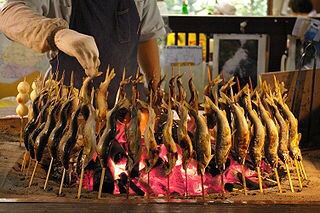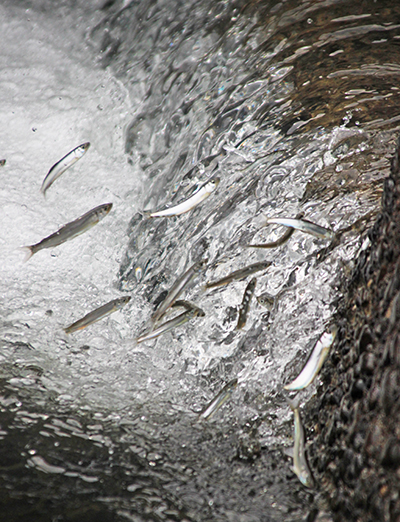Fishing for Ayu; “The Queen of the River”
Ayu (Ayu sweetfish, Plecoglossus altivelis) is a special species of fish in Japan.
People call it “the queen of the river” in Japan. There are several reasons for it.
Firstly, it tastes very well. Secondly, the life cycle of Ayu impresses Japanese people. And most importantly for us, there is a special method to catch them and it drives many anglers crazy.
Image from NHK World.
Taste of Ayu
As its name, sweetfish, tells you, it has an indulging taste, though there is no real sweetness in it. The smell of this fish is like a fruit. Some say the smell is like that of watermelon. Its meat has a fine texture like the meat of very small scallops. When it is grilled with salt on its surface, the fish flavor combines with the crispy flavor of its skin. This cooked meat with salt on its skin gives you the wildly grilled fish of a white meat. Additionally, since it is cooked with its guts remaining, the subtle bitterness of cooked guts makes the taste of meat enhanced, to be more sweet-like taste.
Below link shows about its taste, also. https://umesekotour.com/why-dont-you-taste-ayu-sweetfish-the-most-precious-unique-fish-in-the-world/

Even the oldest book in Japan (Kojiki) described this fish, as people enjoyed catching it for its taste. It explained that the region of Tsukushi (current Fukuoka prefecture, in Kyushu island) had this fish. People were catching it using cooked rice grains.
However, you will know that the taste they had is not what we experience with mature Ayu, as you will read through this article. It is because the grown up Ayu can not be caught with baits such as cooked rice, but one may be able to get small Ayu with such bait. Adult Ayu live on algae to hold the special flavor, and smaller Ayu which feeds on other food sources does not have the special flavor.
The life of Ayu
Ayu is inhabited almost all over Japan (except the northern side of Hokkaido Island). It is spending the amphidromous life coming up and down the Japanese rivers.
It is spawned in lower parts of rivers, in autumn, then baby Ayu is swimming down to the sea. Babies are nurtured in the rich environment along the coast until next spring. In late spring, at the size of 5 - 10 cm, they start to swim up their mother rivers. In this period, they are eating small baits, such as planktons, small shrimps and worms. They go up to the middle part of the river by summer time.
Photo of schooling baby Ayu
And below newspaper article shows the interesting photo of small Ayu swimming up the waterfall.
Uniqueness of Ayu begins here. In summer, they suddenly start to feed on algae grown on stones. This brings the special flavor to its meat. Then, they begin to make each territory around better stones with algae. Strong individuals keep their stone, and invaders will be under the attack.
Photo of scraped algae on a stone
Photo is from https://en.wikipedia.org/wiki/Ayu_sweetfish#/media/File:Plecoglossus_altivelis_altivelis_hami-ato1.jpg
After they feed enough on algae, by autumn, Ayu goes back to the lower part of the river to lay eggs. Then it finishes its life.
The life of Ayu lasts only one year. This short and intense life has kept Japanese people fascinated. We love Sakura (Cherry blossom) for its blistering way to bloom. It blooms before leaves are sprouting on branches, showing solely its flowers first. Then flowers can stay only a week or two. It is very strong at one time, but fragile in the end. This swift closure of drama connects to the value that “nothing lasts forever.” Everything has its ending to start new life, reincarnation of lives. We see it in Ayu fish, in the bottom of our hearts, and this cultural basis gives the fish special significance in our lives.
If you are interested in such cultural background, you can start browsing the links below.
About Sakura; https://www.bbg.org/news/cherry_trees_in_japanese_folklore
About “nothing lasts forever”; https://www.tokyoweekender.com/2020/06/discovering-wabi-sabi-accepting-lifes-imperfections/
Fishing for Ayu
Already some of you have wondered how to catch them, especially when you have noticed grown Ayu fed on algae within its territory.
Japanese anglers' solution is to use decoy. They let a decoy fish, which carries a hook on its back, go into the territory of others. Then, for defense, the territory holder attacks the decoy, bumping or hitting. Unfortunate defender will be on the hook, tied up onto the decoy, and ends up in the hands of the angler.
It is easy to say, but hard to imagine how.
Firstly, here is the rig for it.
Image is from here.
The numbers written in the figure is gou, a thickness unit for fishing line in Japan. 1-gou is about 0.17mm in diameter of monofilament line, and approximately 4lb.
The whole tackle and rigs look like this.
http://manabe.o.oo7.jp/english/keiryuu/ayu.htm
This figure is from the link below, which explains this fishing in detail.
It uses a very long whip rod. It should be soft enough to keep the line from breakage and strong enough to lift two fish.
In the video below, you can get an idea how the fishing goes.
The first thing Ayu angler does is to buy a few decoy fish, nearby the river. On the water, after the rig is on the rod, the angler attaches the decoy onto the line and settles the treble hook on it.
Then he let it swim into the current.
The most intriguing technique is to control this decoy into the target spot. Angler targets the better looking stone, with nice algae color and good strong defender of the stone. Using the fish behavior that it tries to head in the opposite direction from it is pulled. The complication goes on while doing it inside of the strong and complex river current. He uses the line’s water resistance to pull the fish in the desired direction. In this, to pull is not the only solution. Sometimes, it is better to loosen the line to gain more water resistance to pressure the decoy.
Within the territory, the decoy fish senses the attack of the defender. Here, anglers can feel it through line and rod, since the line is very thin (additionally, when he uses thinner line such as braided line or metal composite line, it virtually cut the water), and it is directly connected to the rod, which is made from highest quality carbon, to transfer the vibration very well. He anticipates the uneasiness of his decoy, keeping control of it.
Strike! The strike is very strong, as the defender is forcefully attacking the decoy. Then there comes a very strong pull of the fish. Because Ayu is always swimming in the river, they are like well trained athletes. They fought together and these two athletes are on your fishing line. And push of the water added, they are hard to be taken away from the water surface.
The last but not least point of the fishing is netting. You pull the fish up, then you catch them up in the air. For this, we have special types of net.
You can view it in this video.
As you get an ex-defender of territory, you use it for the new decoy. With using freshly caught fish as decoy, it can easily swim into other fish’s territory, which brings the angler the higher possibility to get the next one.
I hope you can understand what Ayu is about and how the Ayu fishing goes. Are you interested in it? Why don’t you come and visit us in Japan.


One thought on “Fishing for Ayu; “The Queen of the River””